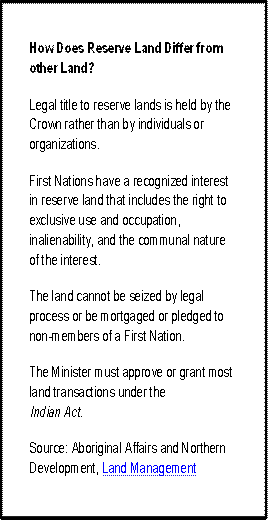AANO Committee Report
If you have any questions or comments regarding the accessibility of this publication, please contact us at accessible@parl.gc.ca.
PART I – RESERVE LAND MANAGEMENT:
|
|
Type of Registry |
Total First Nations Land Base |
|
Indian Lands Registry System (Indian Act Land Base) |
3,385,950[27] |
|
First Nations Land Registry System (Land Control under FNLM) |
148,155 |
|
Self-Governing First Nations |
17,499 |
|
Total Land Base |
3,551,430 |
Source: Aboriginal Affairs and Northern Development Canada, Land Base Statistics.
It is important to note that customary land holdings and any other unregistered, unapproved transfers of lawful possession would not show up on a search of the ILRS.
E. The Federal Role
AANDC and the Minister exercise the greatest authority in relation to First Nations land management under the Indian Act. Importantly, the Department’s role decreases as First Nations move away from the Indian Act and toward more autonomous regimes, such as the FNLMA.
AANDC carries out a range of land administration functions and transactions for First Nations operating under the Indian Act regime, including:[28]
- Approving individual land allotments (CPs) and related transactions;
- Issuing permits and leases for activities on-reserve, including commercial, industrial and residential activities;
- Designating land for leasing;
- Registering interests in the ILRS;
- Reviewing and recommending proposals for Additions to Reserve (ATR) policy;
- Surveying reserve boundaries and individual parcels;
- Monitoring compliance in respect of terms of leases and permits, and collecting revenues;
- Managing environmental issues, including environmental assessment, remediation of contaminated sites, and solid waste management.
The Department also assists First Nations in developing their land management capacity through its Reserve Land and Environment Management Program (RLEMP).[29] Initially launched in 2005 as a pilot program, RLEMP replaces the Department’s previous land management programs (53/60 Delegated Authority and Regional Lands Administration Programs) and expands the responsibilities transferred to First Nations under those programs.
Designed to be a more fully integrated land and environmental management program, RLEMP seeks to establish the conditions under which First Nations are able to exercise increased responsibility over their reserve lands, including environmental management, rather than having those functions performed primarily by the Department. Specifically, First Nations are able to assume certain responsibilities under the Indian Act, such as community land use planning, environmental management, natural resources management, compliance monitoring, and administration of land transactions.[30]
Under the Program, First Nations also receive financial support for land management, and can participate in a two-year professional capacity building program delivered by the University of Saskatchewan and the National Aboriginal Lands Managers Association. To be eligible to participate in RLEMP, a First Nation must have a land manager, active registered land transactions, and a track record of good financial management.[31]
F. Land Modernization
In addition to the reform and consolidation of its land management programs, since the 2009 launch of the Federal Framework for Aboriginal Economic Development,[32] the federal government has sought to identify a range of options to allow First Nations greater control over their lands and resources. A key aspect of this “land modernization” agenda is to ensure that appropriate land management tools, including legislative and regulatory initiatives, are put in place to facilitate economic development on reserves.[33] Recent federal reforms in this area include the following measures:
- Bill C-45: The Jobs and Growth Act, 2012, simplified the process by which First Nations can lease designated lands, by reducing the voting threshold prescribed by the Indian Act from a double majority to a simple majority community vote, and by allowing the Minister of Aboriginal Affairs rather than the Governor in Council to approve land designations.[34]
- The establishment of a joint AANDC-Assembly of First Nations working group on ATR to explore options to expedite the lengthy ATR process in order to enable First Nations to take advantage of economic opportunities.[35]
- A commitment in Budget 2011 to reallocate up to $20 million in funding over two years to allow for new entrants into the FNLMA. Subsequently, in 2011, Canada and the First Nations Lands Advisory Board signed a memorandum of understanding regarding a new funding formula, paving the way for 18 additional First Nations to join the FNLM regime in January 2012. A further $9 million was committed in Budget 2013 to expand the First Nations Land Management Regime, supporting eight new entrants.[36]
- Legislative amendments to the FNLMA eliminating the requirement to conclude environmental management agreements with the federal government prior to developing local environmental laws.[37]
A potentially significant proposal for reserve land tenure reform was announced in Budget 2012. Endorsing a previous recommendation of the House of Commons Standing Committee on Finance,[38] the federal government signalled its intention to explore with interested First Nations the option of moving forward with legislation that would allow private property ownership within current reserve boundaries.[39] This proposal, advanced by the First Nations Tax Commission, is discussed in greater depth later in the report.
G. What the Context Tells Us
This cursory review of the reserve land management framework hints at the special challenges presented when contemplating reforms. Although the Indian Act can frustrate and delay reserve economic development, it is also seen as affording First Nations certain protections, especially with regard to preserving the integrity of the reserve land base. This seeming contradiction was captured by Andrew Beynon, Director General, Community Opportunities Branch, AANDC, who noted that while many First Nations are desirous of full autonomy over the governance of their lands, others prefer not to terminate Canada’s role in respect of those lands, considering that “Canada owes specific fiduciary obligations related to reserve lands.”[40]
These conflicting roles, together with differing conceptions of the land, tenure arrangements and community capacity can intensify the complexities of reform. Despite these challenges, many First Nations are seeking to develop modern and professionally managed land management systems that will allow their communities to tap into outside investment as well as the wealth locked in their lands and resources. The next two sections summarize what the Committee heard in respect to some of the challenges confronting First Nations in developing reserve lands and their proposals for addressing some of those challenges.
[9] Marena Brinkhurst and Anka Kessler, p. 2.
[10] Joan Holmes, “Reserve Land Surrenders: Best Practices for Documenting Historic Grievances,” July 2006.
[11] The Constitution Act, 1867, 30 & 31 Vict., c. 3.
[12] Under modern treaties, however, settlement lands are owned in fee simple by the Aboriginal groups and are no longer considered “Lands reserved for the Indians” under subsection 91(24) of the Constitution Act, 1867, or, for First Nations, reserves within the meaning of the Indian Act.
[13] Jack Woodward, Native Law, “Aboriginal Titles and Indian Lands”, Volume 1, Chapter 8, 1989.
[14] See for example, Lang Michener LLP, “Best Practices in First Nations’ Land Administration Systems”, 2007.
[15] Government of Canada, First Nations Land Management Act (S.C. 1999, c. 24).
[16] Additional information on the First Nations Land Management Act is available online at the First Nations Land Management Resource Centre web site.
[17] Assembly of First Nations (British Columbia), “Land Management”, Part 1, Section 3:19.
[18] The Nisga’a legislation allows homeowners on former Indian reserves on Nisga’a land in northwestern British Columbia to apply to have their property transferred to fee simple ownership, meaning that Nisga’a citizens could mortgage or sell their residential property, but with control maintained by Nisga’a village governments. The legislation is limited to residential properties, such that large-scale commercial property development is excluded. For further information, see Nisga’a Lisims Government, Nisga'a Landholding Transition Act, October 2009.
[19] AANDC, “Fact Sheet: Comprehensive Land Claims.”
[20] Section 20 of the Indian Act states that: “No Indian is lawfully in possession of land in a reserve unless, with the approval of the Minister, possession of the land has been allotted to him by the council of the band.” Parliament’s 91(24) authority is generally considered plenary, or without subject matter limitation. As such, its enactment of the communal and inalienable features of reserve lands in the Indian Act does not preclude it from concurrently providing for individual fee simple ownership of the same lands under prescribed conditions in that Act or elsewhere.
[21] Thomas Flanagan and Christopher Alcantara, “Individual Property Rights on Canadian Indian Reserves,” Public Policy Sources, Fraser Institute, No. 60, July 2002, p. 3.
[22] Membertou and Lac La Ronge First Nations have taken steps to survey and document customary land holdings on reserves. See, Thomas Flanagan and Katrine Beauregard, “The Wealth of First Nations: An Exploratory Study,” Fraser Institute, June 2013, p. 9.
[23] Marena Brinkhurst and Anka Kessler, p.4.
[24] For additional information on the process of leasing lands on reserves, see, Bob Starkell, Leases on Indian Reserves,” October 2006.
[25] For additional information regarding the Indian Lands Registry System, see Lang Michener LLP, “Best Practices in First Nations’ Land Administration Systems,” 2007.
[26] AANDC, “Land Registration.”
[27] Please note that, as of February 2013, the total reserve land base totalled 3.8 million hectares.
[28] House of Commons, AANO, Evidence, 1st Session, 41st Parliament, 24 November 2011, (Andrew Beynon, Director General, Community Opportunities Branch, AANDC).
[30] Office of the Auditor General of Canada, 2009 Fall Report of the Auditor General of Canada, “Chapter 6 - Land Management and Environmental Protection on Reserves,” 2009.
[31] Ibid.
[33] AANDC, “Update on the Implementation of the Federal Framework for Aboriginal Economic Development,” 2012.
[34] Bill C-45, A second Act to implement certain provisions of the budget tabled in Parliament on March 29, 2012 and other measures. See, in particular, Part 4 – Division 8.
[35] AANDC, “Canada–First Nations Joint Action Plan,” News release, June 2011. In July 2013, AANDC released proposed revisions to the 2001 Additions to Reserves Policy. The proposed revisions to the Policy would streamline the ATR proposal and remove duplication; clarify roles and responsibilities; and, facilitate economic development. Additional information is available here.
[36] AANDC, Harper Government Opens Door to Greater First Nations Control over Lands and Resources, 25 March 2013.
[37] Bill C-38, Jobs, Growth and Long-term Prosperity Act. See, in particular, Part 4-Division 46.
[38] House of Commons Standing Committee on Finance, Staying Focused on Canadian Jobs and Growth, 1st Session, 41st Parliament, December 2011.
[39] Government of Canada, Economic Action Plan 2012 - A Plan for Jobs, Growth and Long-Term Prosperity, March 2012.
[40] House of Commons, AANO, Evidence, 1st Session, 41st Parliament, 24 November 2011, (Andrew Beynon, Director General, Community Opportunities Branch, AANDC).

 The First Nations Land Management Act (FNLMA) provides the
only alternative to land management under the Indian Act, outside of
modern treaties and stand-alone self-government arrangements.
The First Nations Land Management Act (FNLMA) provides the
only alternative to land management under the Indian Act, outside of
modern treaties and stand-alone self-government arrangements.